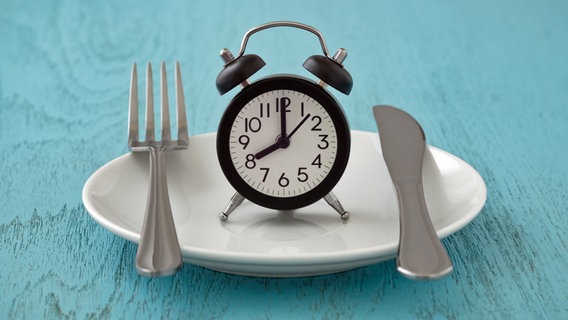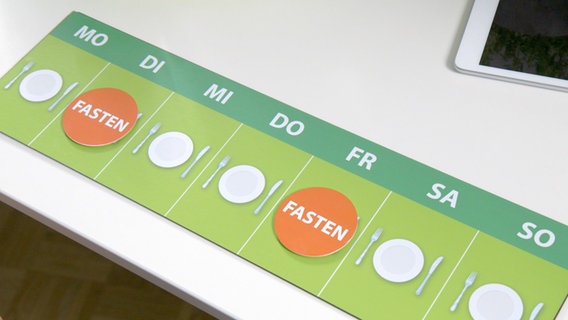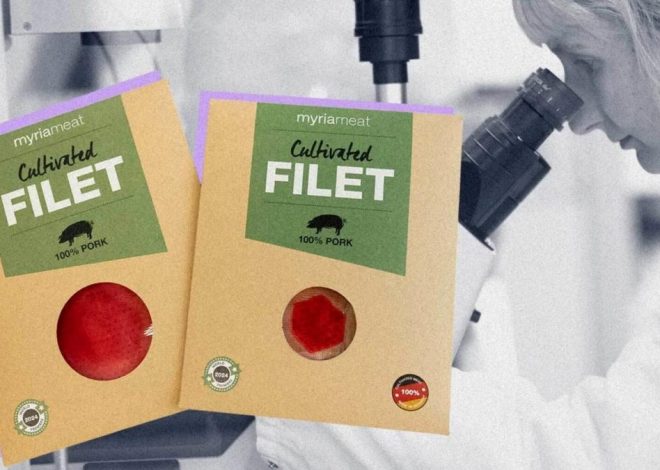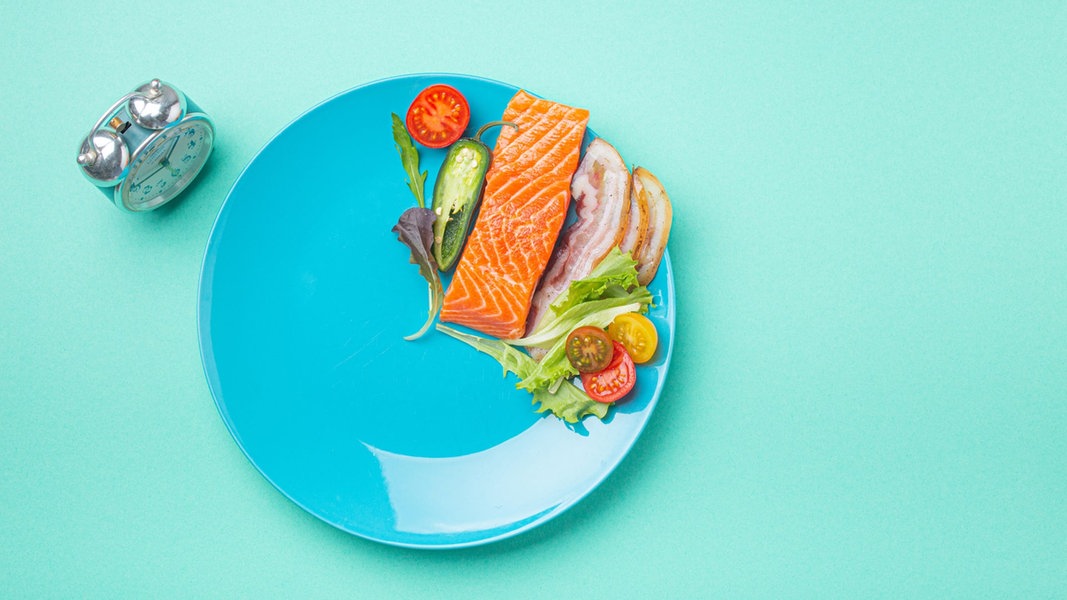
Intermittent fasting: This is how healthy weight loss works | NDR.de – Guide
As of: April 17, 2024 1:40 p.m
| from the
Losing weight and keeping it off – intermittent fasting is supposed to make this easier. Longer breaks are taken between meals. How do the 16:8, 5:2 and 1:1 methods differ and who are they suitable for?
Intermittent fasting is the most important new trend in nutritional medicine. According to previous research results, the method can help you lose weight healthily and maintain your body weight. Apparently, intermittent fasting can even protect against diabetes (type 2). The effects of diet on health and aging processes are currently the subject of many studies. In Reviews have found many positive metabolic effects of short-term fasting as well as good tolerability.
Is intermittent fasting fatal?
In March 2024, a discussion about negative effects arose: According to one Study from Shanghai based on US health data suggests that intermittent fasting almost doubles the risk of dying from cardiovascular disease. However, the study that made the headlines did not deal with planned intermittent fasting at all: it included existing data from people who ate their meals within less than eight hours on two randomly selected days, for whatever reason – shift work, previous illness or other . This study therefore has little significance with regard to the question of how intermittent fasting affects health or the risk of death. Long-term studies among people on intermittent fasting as part of a conscious diet are lacking.
Be careful with previous illnesses
Although intermittent fasting has been proven to benefit many, some people should still exercise caution. You should definitely consult your doctor before you start
- low blood pressure
- Metabolic diseases
- chronic diseases
- Cancer diseases
- high age.
Intermittent fasting is generally not suitable:
- during pregnancy and breastfeeding
- for eating disorders such as anorexia, bulimia, binge eating
- if you are underweight
- for migraines.
What methods are there for intermittent fasting?
Fasting means giving up certain foods, drinks and stimulants, either briefly or for a longer period of time. When it comes to intermittent fasting, you can choose between different variants:
- 16:8-Method: There are 16 hours between the last meal of the previous day and the first meal of the day. Two meals are eaten during the eight hours in which one is allowed to eat.
- 5:2-Method: Eat normally five days a week and very little on two days.
- 1:1-Method: (Alternating fasting or alternate day fasting): With this variant, you eat normally one day, and the next day you are only allowed to consume around 25 percent of the usual amount of energy. So you always alternate between “normal” days and fasting days.
Further information
Why short-term fasting is so effective
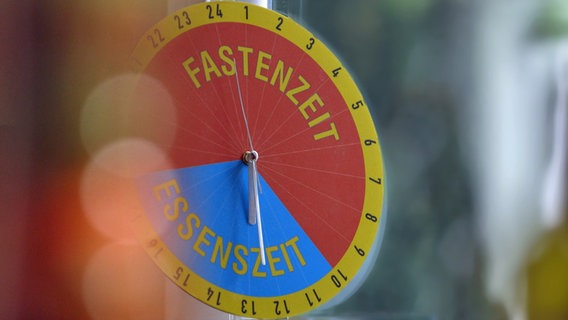
Nothing to eat for 16 hours, only two meals within eight hours: Intermittent fasting gives the body plenty of time to burn fat.
Since the Stone Age, the human metabolism has been adapted to fasting phases. When there was plenty, our ancestors ate freely; in times of scarcity, their stomachs remained empty for a few hours or days. The human body survives long periods of hunger by storing energy reserves in various organs and tissues and mobilizing them again when needed. However, it also reduces energy consumption – and after a few days begins to break down protein in the muscles.
The crucial difference between interval fasting and longer fasting regimens or crash diets: The metabolism is not slowed down and muscle mass is not lost. This is very important because it avoids the dreaded yo-yo effect.
Fasting also leads to beneficial biochemical changes in the body, such as improved sugar and fat metabolism: substances are released that can relieve inflammation.
Studies: Positive effect on body weight
Scientific Studies on mice have shown that animals that only eat within a certain time window stay slim and live longer than their counterparts who had access to food around the clock – and with the same number of calories. An explanation: A break from eating for at least 14 hours triggers a type of cleansing process in our cells called autophagy. Damaged cell parts are covered by a membrane and digested. This recycling program makes aged cells fully functional again and could even slow the aging process.
Fasting using the 5:2 method
A popular form of intermittent fasting is the 5:2 diet: You can eat as usual five days a week without counting calories. On two days, the food intake is reduced to 500 to 800 calories for women and to 600 to 850 calories for men. It is important to drink lots of calorie-free foods. Quickly digestible carbohydrates such as light bread, pasta, potatoes and sugar should be completely avoided on fasting days. This is how the body learns to live from its reserves. The 5:2 method is about as effective as a weight loss aid as a permanent calorie reduction, but is easier to maintain.
Further information
Fasting using the 16:8 method
If you don’t want to fast for whole days, you can incorporate longer meal breaks into your daily routine. With the 16:8 method, you skip either the early or late meal, so you go without food for 16 hours at a time. For example, if you don’t eat anything after 5 p.m., you can have breakfast again at 9 a.m. the next morning. This puts your metabolism into a short fast every night. Even if you eat large portions in the two remaining meals, you automatically consume less than in three (or more) meals – overall, your calorie intake is reduced by an average of five to ten percent.
The potential for losing weight with this method has been scientifically proven. It can also help against diseases associated with obesity, such as high blood pressure or type 2 diabetes. Another pleasant side effect: the body has less to do with digestion at night, which benefits the quality of sleep. If you can’t last 16 hours without food, you should initially try 12 or 14 hours and then increase the nightly fasting break by 30-60 minutes every week. The organism gradually gets used to the rhythm.
Fasting using the 1:1 method
The 1:1 diet – also called alternating fasting, alternate day fasting or every other day fasting (EODF) – involves fasting every other day. This is a bit of a challenge for the body. If you want to try them out, you should always consult a doctor beforehand. When alternating fasting, it is particularly important to pay attention to a balanced diet in order to supply the body with all the important nutrients.
What can you drink while intermittent fasting?
You can and should drink while fasting – but only calorie-free drinks such as water, thin vegetable broth, unsweetened tea or moderate black coffee.
How many hours break between meals?
With all short-term fasting variants, it is important not to eat more frequently or significantly more than usual during the food intake phases. There should be breaks of at least four to five hours between meals. If you consume carbohydrates every now and then – whether biscuits, crispbread, fruit juice or milk – then your body converts them into sugar. And it goes straight into the blood: the blood sugar level rises, the body releases insulin and stops fat loss. The rapid insulin peak in the blood can lead to mild, short-term hypoglycemia and food cravings.
Intermittent fasting: The most important things at a glance
- Avoid physical exertion while fasting until you have completely gotten used to the new rhythm.
- Continue to eat normally, no double portions.
- To get and stay full, make sure you eat enough vegetables (Fiber) and protein sources (dairy products, eggs, fish, meat, legumes, mushrooms or nuts) with every meal.
- No snacks between meals! Calorie drinks such as coffee with milk or juice are also snacks.
- Calorie-free drinks such as water or unsweetened tea help to bridge hunger gaps during the food-free period.
- After your first meal, take a short walk or do a little exercise to help with digestion.
Experts on the topic
Recipes for relief days without milk and wheat
Fasting recipes without milk and wheat
Further information


Ethel Purdy – Medical Blogger & Pharmacist
Bridging the world of wellness and science, Ethel Purdy is a professional voice in healthcare with a passion for sharing knowledge. At 36, she stands at the confluence of medical expertise and the written word, holding a pharmacy degree acquired under the rigorous education systems of Germany and Estonia.
Her pursuit of medicine was fueled by a desire to understand the intricacies of human health and to contribute to the community’s understanding of it. Transitioning seamlessly into the realm of blogging, Ethel has found a platform to demystify complex medical concepts for the everyday reader.
Ethel’s commitment to the world of medicine extends beyond her professional life into a personal commitment to health and wellness. Her hobbies reflect this dedication, often involving research on the latest medical advances, participating in wellness communities, and exploring the vast and varied dimensions of health.
Join Ethel as she distills her pharmaceutical knowledge into accessible wisdom, fostering an environment where science meets lifestyle and everyone is invited to learn. Whether you’re looking for insights into the latest health trends or trustworthy medical advice, Ethel’s blog is your gateway to the nexus of healthcare and daily living.







